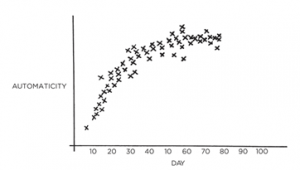It is easy to get bogged down trying to find the optimal plan for change: the fastest way to lose weight, the best program to build muscle, the perfect idea for a side hustle. We are so focused on figuring out the best approach that we never get around to taking action.
The difference between being in motion and taking action is when you’re in motion, you’re planning and strategizing and learning. Those are all good things, but they don’t produce a result. Action, on the other hand, is the type of behavior that will deliver an outcome.
For instance, if you search for a better diet plan and read a few books on the topic, that’s motion. But if you actually eat a healthy meal, that’s action. Sometimes motion is useful, but it will never produce an outcome by itself.
Only the action of working out will get the result you’re looking to achieve. Sometimes we do motion because we actually need to plan or learn more. But more often than not, we do it because motion allows us to feel like we’re making progress without running the risk of failure. Most of us are experts at avoiding criticism. It doesn’t feel good to fail or to be judged publicly, so we tend to avoid situations where that might happen. And that’s the biggest reason why you slip into motion rather than taking action: you want to delay failure. It’s easy to be in motion and convince yourself that you’re still making progress.
Motion makes you feel like you’re getting things done. But really, you’re just preparing to get something done. When preparation becomes a form of procrastination, you need to change something. You don’t want to merely be planning. You want to be practicing.
If you want to master a habit, the key is to start with repetition, not perfection. You don’t need to map out every feature of a new habit. You just need to practice it.
How long does it actually take to form a new habit?
Habit formation is the process by which a behavior becomes progressively more automatic through repetition. The more you repeat an activity, the more the structure of your brain changes to become efficient at that activity. Neuroscientists call this long-term potentiation, which refers to the strengthening of connections between neurons in the brain based on recent patterns of activity. With each repetition, cell-to-cell signaling improves and the neural connections tighten.
Repeating a habit leads to clear physical changes in the brain. A repetition is a form of change. Each time you repeat an action, you are activating a particular neural circuit associated with that habit. This means that simply putting in your reps is one of the most critical steps you can take to encode a new habit.
One group engaged in active practice, the other in passive learning. One in action, the other in motion. All habits follow a similar trajectory from effortful practice to automatic behavior, a process known as automaticity. Automaticity is the ability to perform a behavior without thinking about each step, which occurs when the nonconscious mind takes over.
The habit lines

At the beginning (point A), a habit requires a good deal of effort and concentration to perform. After a few repetitions (point B), it gets easier but still requires some conscious attention. With enough practice (point C), the habit becomes more automatic than conscious. Beyond this threshold—the habit line—the behavior can be done more or less without thinking. A new habit has been formed.

This graph shows someone who built the habit of walking for ten minutes after breakfast each day. Notice that as the repetitions increase, so does automaticity, until the behavior is as easy and automatic as it can be.
One of the most common questions is “How long does it take to build a new habit?” But what people really should be asking is, “How many does it take to form a new habit?” That is, how many repetitions are required to make a habit automatic? There is nothing magical about time passing with regard to habit formation.
What matters is the rate at which you perform the behavior. You could do something twice in thirty days, or two hundred times. It’s the frequency that makes the difference.
New habits require the same level of frequency. You need to string together enough successful attempts until the behavior is firmly embedded in your mind and you cross the Habit Line.
In practice, it doesn’t really matter how long it takes for a habit to become automatic. What matters is that you take the actions you need to take to make progress. Whether an action is fully automatic is of less importance. In fact, to build a habit, you need to practice it.
In summary, the most effective form of learning is practice, not planning. Habit formation is the process by which a behavior becomes progressively more automatic through repetition.
Note that the amount of time you have been performing a habit is not as important as the number of times you have performed it. Also, you can use the Habitomic app to control and manage your mini habits.

